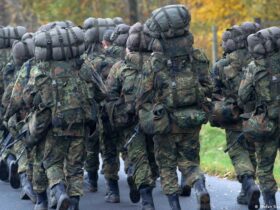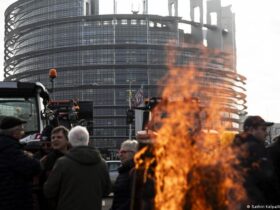On October 7, 2023, several thousand Islamist fighters under the command of Hamas infiltrated into Israel from the Gaza Strip, killing about 1,200 and taking more than 250 hostages.
Over the next 15 months, the Israeli Defense Forces (IDF) bombed and captured large parts of Gaza. Hamas fought back against Israeli forces and fired rockets at Israel in return. The militant Islamic organization is classified as a terrorist organization by Israel, its Western allies, and some Arab states.
Estimates vary as to how many Palestinians have been killed in the conflict between Israel and Hamas, but everyone agrees that the figure is in the 10’s. Humanitarian organizations say even more people have died from indirect consequences of the fighting. According to the United Nations, almost the entire population of the Gaza Strip has been driven from their homes. For its part, Israel has reported that several hundred of its soldiers and other members of the security forces have been killed.
On Wednesday, January 15, 2025, Qatar announced a breakthrough in negotiations to end the violent conflict between Israel and Hamas. For several months now, the Emirates have been hosting and mediating talks between the two sides, along with the US, Egypt and Turkey, whose representatives do not communicate directly with each other. Now a plan for a six-week ceasefire has been announced.
What is included in the Gaza agreement?
If the agreement is finalized, the ceasefire will begin at 12:15 a.m. local time on Sunday (January 19, 2025) for an initial period of six weeks. Israel wants to start withdrawing its troops from the Gaza Strip. Both sides also want to release the prisoners. Humanitarian aid corridors that are currently blocked will be opened to assist organizations entering the Gaza Strip.
How many prisoners and hostages will be exchanged?
The first phase of the ceasefire will last 42 days, during which Hamas will release 33 hostages to Israel: first all remaining women and children, then men over the age of 50. The first three hostages are expected to be freed on Sunday.
At this time, 98 of the more than 250 kidnapped hostages are still held by Hamas. It is unclear how many still survive. To date, 36 hostages have been declared dead, while more than 110 have either been freed or left alive.
In exchange for the release of the hostages, Israel would release Palestinian prisoners: 30 for each civilian hostage and 50 for each female soldier. Some of the released Palestinian prisoners will be Hamas fighters, but no one who took part in the October 7, 2023 terrorist attack will be included in the exchange.
From which areas will Israel withdraw?
It is not yet clear from which areas the Israeli army will withdraw and where it intends to stay. Reports indicate that it will mainly spare densely populated areas of the Gaza Strip. The Netzarim corridor, which cuts the Gaza Strip in half just south of Gaza City, is also expected to gradually reopen. This will allow displaced people from the northern part of the strip to return to their homes, or what remains of them. This will also greatly facilitate the transportation of aid within the area.
The IDF will likely only allow the opening of the “Philadelphia Corridor”, Israel’s codename for the strip running along the border between Gaza and Egypt, during the second phase of the agreement. This corridor is one of the main obstacles to the delivery of humanitarian aid.
However, it appears that the plan will include opening the Rafah border crossing in the south. Along with other entry points, this will allow much more food, medicine and other supplies to be brought into the Palestinian territory than before.
What will happen after the first phase of ceasefire?
No consensus has yet been reached on how to proceed after the first, six-week phase. The two sides still have to negotiate terms for continuing the ceasefire, the withdrawal of Israeli troops from Gaza and additional exchanges of hostages and prisoners. If these talks fail, fighting will likely resume.
Who can take credit for the Israel-Hamas deal: Joe Biden or Donald Trump?
In addition to Qatar, representatives of Egypt, Türkiye, and the United States were involved in mediation between the Israeli government and Hamas. The United States is currently in the midst of a transition between its outgoing president, Joe Biden, and President-elect Donald Trump, who is scheduled to be inaugurated on Monday. Both men have claimed success of the talks for themselves.
In an interview with German Radio, political scientist Johannes Thimm of the German Institute for International and Security Affairs (SWP) described the result as a “shared success”. President Biden is still in office, and Thimm remarked that his team has clearly done a great job for the US during several months of negotiations in Qatar. However, Thimm said: “The threat Trump posed may also have played a role.” Another important factor, he said, is that Israel has managed to achieve many of its military objectives.
Last week Donald Trump issued a warning to Hamas. He said, “If those hostages are not returned by the time I come into office, there will be all hell in the Middle East.” “And that wouldn’t be good for Hamas, and it wouldn’t be good, frankly, for anybody. All hell would break loose.”
Yet what could cause the agreement to fail?
The Israeli cabinet must approve the ceasefire before it can come into effect. It was supposed to happen on Thursday morning, but the meeting was postponed. Prime Minister Benjamin Netanyahu accused Hamas of withdrawing from parts of the agreement to “demand concessions at the last minute”, a charge denied by a spokesman for the Palestinian side.
Netanyahu’s office confirmed the agreement Friday morning. The reason for the delay was a discrepancy in the agreed prisoner exchange. Israel’s Security Council approved the ceasefire, according to Netanyahu’s office.
The full Cabinet must now approve the agreement.
This article has been translated from German.






Leave a Reply